
Expressionism - II
Ernst Kirchner
1880 – 1938
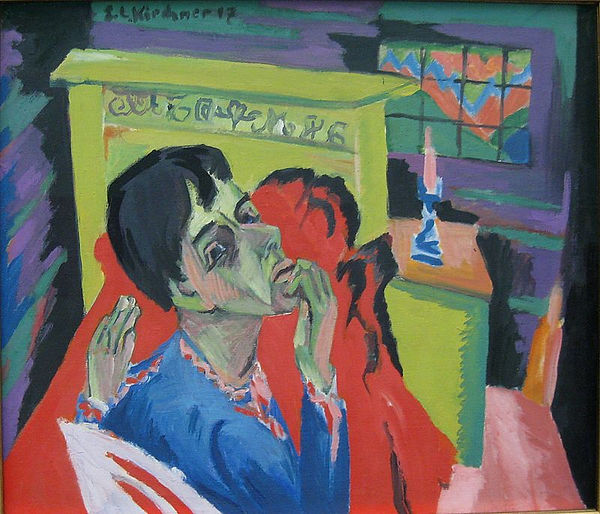
Self-portrait as a Sick Person, 1918
Ernst Ludwig Kirchner
(6 May 1880 – 15 June 1938) was a German expressionist painter and printmaker and one of the founders of the artists group Die Brücke or "The Bridge", a key group leading to the foundation of Expressionism in 20th-century art. He volunteered for army service in the First World War, but soon suffered a breakdown and was discharged. His work was branded as "degenerate" by the Nazis in 1933, and in 1937 more than 600 of his works were sold or destroyed.

Self-Portrait as a Soldier (1915)

Potsdamer Platz, 1914

Potsdamer Platz, 1914

Berlin Street Scene, 1913

Naked Playing People, 1910

Sertig Valley in Autumn, 1925

Street, Berlin (1913)

Böhmischer Waldsee (Bohemian Forest Lake), 1911

Standing Nude with Hat, 1910

Vier Holzplastiken, 1912

Marzella (1909–10)
Gustave Van de Woestijne
1881 - 1947
Gustave Van de Woestijne
(Dutch: [vɑn də ʋuˈstɛinə]; 2 August 1881 – 21 April 1947) was a Belgian expressionist painter.
He belonged to the so-called "First Group of Latem", a group of artists who worked in the rural village of Sint-Martens-Latem on the banks of the Lys, near Ghent. He was the brother of the Flemish poet Karel Van de Woestijne. He was buried in the Cemetery of Campo Santo.

Laatste Avondmaal, Gustave van de Woestyne, 1927

Gustave van de Woestyne, Boerin, ca. 1925

Gustave van de Woestyne, The Blind Man, 1910

Gustave van de Woestyne, The Sleepers, 1918

Gustave van de Woestyne, Adrienne, 1921

Gustave van de Woestyne, The Liqueur Drinkers, 1922

Gustave van de Woestyne, Gaston and His Sister, 1923

Gustave van de Woestyne, Azure, 1928

Gustave van de Woestyne, Still life with Grapes, 1937

Gustave van de Woestyne, Christ Showing His Wounds, 1921

Gustave van de Woestyne, De twee lentes, 1910

Gustave van de woestyne, Fuga, 1919

Gustave van de Woestyne, De slechte zaaier, 1908

Gustave van de Woestyne, The children’s table, 1919
Hermann Pechstein
1881 – 1955
.jpg)
Hermann Max Pechstein
(31 December 1881 – 29 June 1955) was a German expressionist painter and printmaker and a member of the Die Brücke group. He fought on the Western Front during World War I and his art was classified as Degenerate Art by the Nazis. More than 300 paintings were removed from German Museums during the Nazi era.
Pechstein was born in Zwickau, the son of a craftsman who worked in a textile mill. The family of eight lived on the father's salary. An early contact with the art of Vincent van Gogh stimulated Pechstein's development toward expressionism. He first worked as a decorator in his home town before enrolling at the School of Applied Arts and then at the Royal Art Academy in Dresden, where he met the painter Otto Gussman and the architect Wilhelm Kreis. It was here, starting in 1902, that he became a pupil of Gussmann; a relationship that lasted until 1906 when Pechstein met Erich Heckel and was invited to join the art group Die Brücke. He was the only member to have received formal art training. He was an active member of the Brücke until 1910 and often worked alongside Brücke painters creating a homogeneous style of this period. In 1905 he was in Dresden where the museum of ethnology showed wood carvings from the South Seas. As a result he developed his first woodcut.

The yellow and black jersey
Max Pechstein
1909

The Masked Woman
Max Pechstein
1910

Bank of a Lake
Max Pechstein
1910

Indian and Woman
Max Pechstein
1910

Girl. Sitting Female Nude
Max Pechstein
1910

Meadow at Moritzburg
Max Pechstein
1910

Dawn
Max Pechstein
1911

Day of Steel
Max Pechstein
1911

The Red Turban
Max Pechstein
1911

Killing of the Banquet Roast
Max Pechstein
1912

Ballet Dancers
Max Pechstein
1912

Italian Church - Convent of San Gimignano
Max Pechstein
1913

Modellpause
Max Pechstein
1925

Under the Trees (Akte im Freien)
Max Pechstein

Sea story
Max Pechstein
Erich Heckel
1883 – 1970
Erich Heckel
(31 July 1883 – 27 January 1970) was a German painter and printmaker, and a founding member of the group Die Brücke ("The Bridge") which existed 1905–1913. His work was part of the art competitions at the 1928 Summer Olympics and the 1932 Summer Olympics.
Heckel was born in Döbeln, Saxony, the son of a railway engineer. Between 1897 and 1904 he attended the Realgymnasium in Chemnitz, before studying architecture in Dresden. He left after three terms, shortly after the foundation of Die Brücke, an artists' group of which he was secretary and treasurer. The other founder-members, also architectural students, were Ernst Ludwig Kirchner, Karl Schmidt-Rottluff and Fritz Bleyl. He worked in the office of the architect Wilhelm Kreis until July 1907, when he resigned to become a full-time artist.

Kirchner - Erich Heckel an der Staffelei
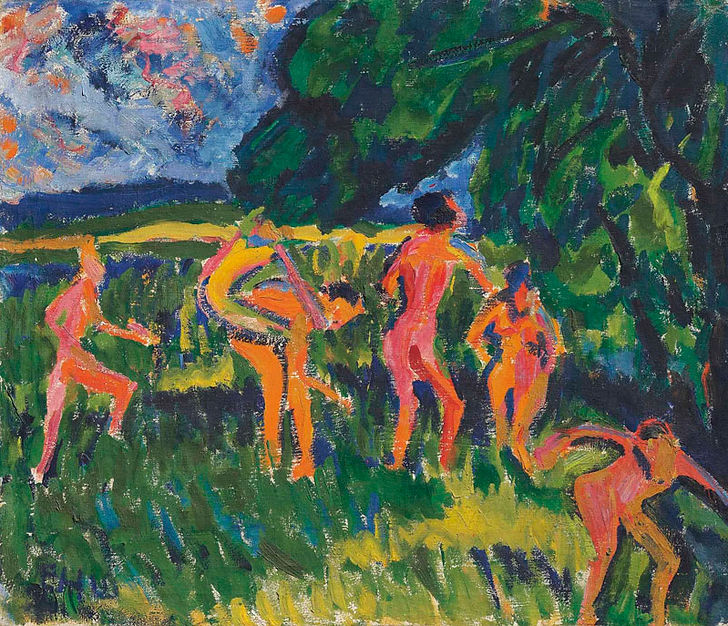
Badende am Waldteich
Heckel, Erich, 1909

Geigerin
Heckel, Erich, 1911

Blaue Iris
Heckel, Erich, 1908

Weisses Haus in Dangast,
Erich Heckel,
1908.

Fränzi Reclining
Erich Heckel

Erich Heckel (German, 1883 - 1970)
Reading Aloud (Beim Vorlesen),
1914

Heckel, Erich
Beim Vorlesen

Betende
1916
Erich Heckel

Erich Heckel
Kind und nackte Frau (Child and naked Woman), 1910

Erich Heckel (1883-1970):
Junger Mann und Mädchen,
1909
Brücke-Museum, Berlin
Marie Laurencin
1883 – 1956

Marie Laurencin
Marie Laurencin
(31 October 1883 – 8 June 1956) was a French painter and printmaker. She became an important figure in the Parisian avant-garde as a member of the Cubists associated with the Section d'Or.
Laurencin was born in Paris, where she was raised by her mother and lived much of her life. At 18, she studied porcelain painting in Sèvres. She then returned to Paris and continued her art education at the Académie Humbert, where she changed her focus to oil painting.
During the early years of the 20th century, Laurencin was an important figure in the Parisian avant-garde. A member of both the circle of Pablo Picasso, and Cubists associated with the Section d'Or, such as Jean Metzinger, Albert Gleizes, Robert Delaunay, Henri le Fauconnier and Francis Picabia, exhibiting with them at the Salon des Indépendants (1910-1911) and the Salon d'Automne (1911-1912), and Galeries Dalmau (1912) at the first Cubist exhibition in Spain. She became romantically involved with the poet Guillaume Apollinaire, and has often been identified as his muse. In addition, Laurencin had important connections to the salon of the American expatriate and lesbian writer Natalie Clifford Barney. She had relationships with men and women, and her art reflected her life, her "balletic wraiths" and "sidesaddle Amazons" providing the art world with her brand of "queer femme with a Gallic twist."
During the First World War, Laurencin left France for exile in Spain with her German-born husband, Baron Otto von Waëtjen, since through her marriage she had automatically lost her French citizenship. The couple subsequently lived together briefly in Düsseldorf. She was greatly affected by her separation from the French capital, the unrivaled center of artistic creativity. After they divorced in 1920, she returned to Paris, where she achieved financial success as an artist until the economic depression of the 1930s. During the 1930s she worked as an art instructor at a private school. She lived in Paris until her death.

Marie Laurencin
Self-Portrait

Marie Laurencin
Apollinaire and his friends

Groupe d’artistes’ by Marie Laurencin (1908) – From left: Pablo Picasso, Marie Laurencin herself, Apollinaire and Fernande Olivier (Picasso’s lover).

Marie Laurencin
1910-11, Les jeunes filles (Jeune Femmes, Young Girls)
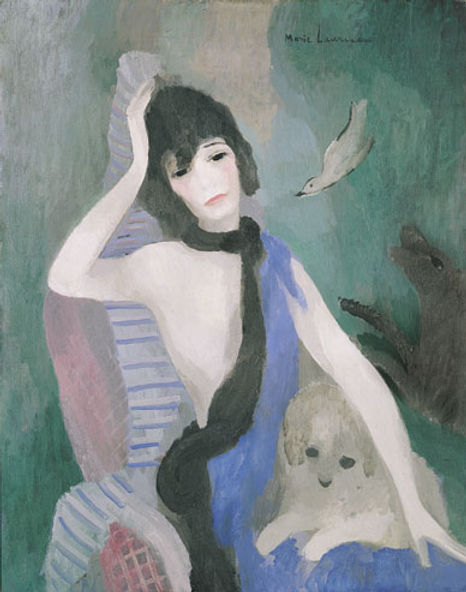
Marie Laurencin
Portrait of Mademoiselle Chanel, 1923

Marie Laurencin
Spanish Dancers

Marie Laurencin
Dancers

Marie Laurencin
Trois jeunes filles aux petits chiens

Marie Laurencin
Woman with Flowers

Marie Laurencin
LA MUSIQUE

Ile-de-France
Marie Laurencin
1940

The Rehearsal
Marie Laurencin
1936

Marie Laurencin
Ballerinas resting

Judith
Marie Laurencin
1930

Marie Laurencin
Portrait of Baroness Gourgaud in Black Mantilla
Max Beckmann
1884 – 1950
Max Carl Friedrich Beckmann (February 12, 1884 – December 27, 1950) was a German painter, draftsman, printmaker, sculptor, and writer. Although he is classified as an Expressionist artist, he rejected both the term and the movement. In the 1920s, he was associated with the New Objectivity (Neue Sachlichkeit), an outgrowth of Expressionism that opposed its introverted emotionalism. Even when dealing with light subject matter like circus performers, Beckmann often had an undercurrent of moodiness or unease in his works. By the 1930s, his work became more explicit in its horrifying imagery and distorted forms with combination of brutal realism and social criticism, coinciding with the rise of nazism in Germany.

Max Beckmann
Self-Portrait with Horn, 1901

Great Scene of Agony
Max Beckmann
1906

Adam and Eve
Max Beckmann
1917

The Descent from the Cross
Max Beckmann
1917
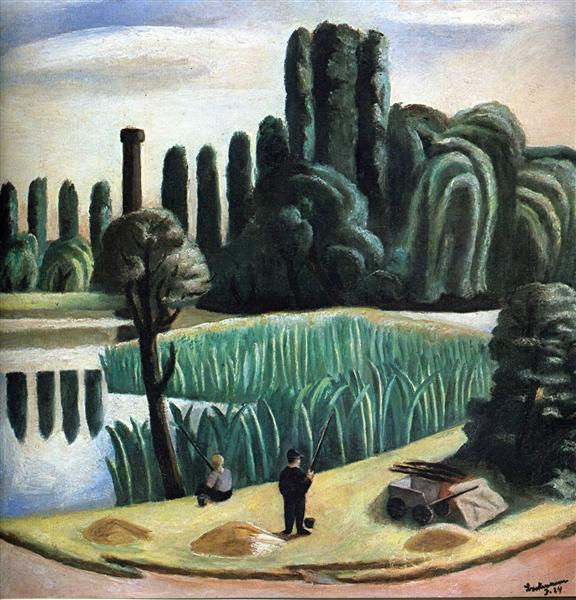
Seascape with poplars
Max Beckmann
1924

Reclining Nude
Max Beckmann
1929

Brother and sister
Max Beckmann
1933

Max Beckmann
Self-Portrait with Horn, 1938

Max Beckmann
Birds’ Hell, 1937–1938

Max Beckmann
The Night (Die Nacht), 1918–1919

Max Beckmann
Departure
1935
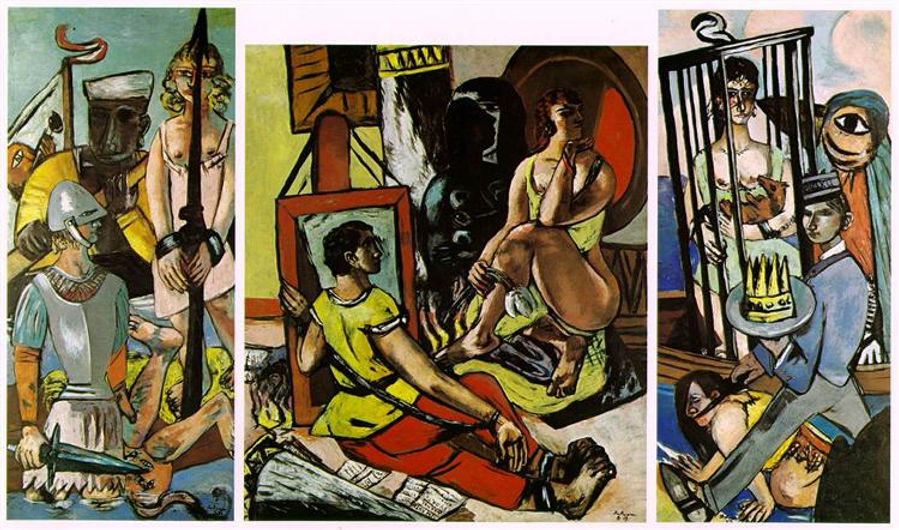
Triptych of the Temptation of St. Anthony
Max Beckmann
1936 - 1937

The acrobats
Max Beckmann
1939

Perseus
Max Beckmann
1940 - 1941

Odysseus and Calypso
Max Beckmann
1943

Blindman's Buff
Max Beckmann
1945

Afternoon
Max Beckmann
1946

Two Circus Artists or Snake Charmer and Clown
Max Beckmann
Original Title: Artistes
1948

Beginnning
Max Beckmann
1949

The prodigal son
Max Beckmann
1949

The Argonauts
Max Beckmann
1949 - 1950
Amedeo Modigliani
1884 –1920

Amedeo Clemente Modigliani (July 1884 – 24 January 1920) was an Italian painter and sculptor of the École de Paris who worked mainly in France. He is known for portraits and nudes in a modern style characterized by a surreal elongation of faces, necks, and figures — works that were not received well during his lifetime, but later became much sought-after. Modigliani spent his youth in Italy, where he studied the art of antiquity and the Renaissance. In 1906, he moved to Paris, where he came into contact with such artists as Pablo Picasso and Constantin Brâncuși. By 1912, Modigliani was exhibiting highly stylized sculptures with Cubists of the Section d'Or group at the Salon d'Automne.
Modigliani's oeuvre includes paintings and drawings. From 1909 to 1914, he devoted himself mainly to sculpture. His main subjects were portraits and full figures, both in the images and in the sculptures. Modigliani had little success while alive but after his death achieved great popularity. He died of tubercular meningitis, at the age of 35, in Paris.

Self-Portrait, 1919

Sorrowful Nude, 1908

Female Nude with Hat 1908

The Amazon1909

Rose Caryatid 1914

Caryatids 1914
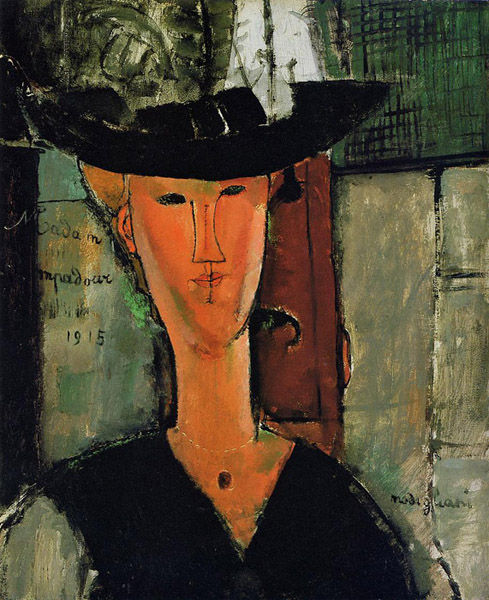
Madame Pompadour 1915

Bride and Groom1916

Portrait of Max Jacob 1916

Portrait of Picasso 1915

Victoria 1916

Portrait of a Woman in a Black Tie 1917

Portrait of Diego Rivera 1914

Portrait of Beatrice Hastings 1916

Raimondo 1915

The Beautiful Confectioner 1916

Young Girl Wearing a Rose 1916

Marguerite Seated 1916

Madame Georges van Muyden 1917

Girl with Braids 1918

Lunia Czechovska 1919

Portrait of Anna Zborowska 1919

Readhead Wearing a Pendant 1918

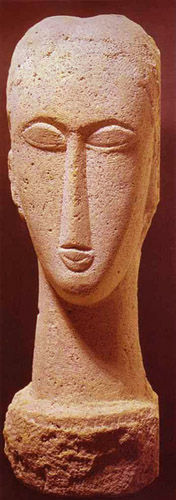


AMEDEO MODIGLIANI:
FEMALE HEAD. 1911-1914.Paris. MNAM



AMEDEO MODIGLIANI:
FEMALE HEAD. 1911-1914. Paris. MNAM
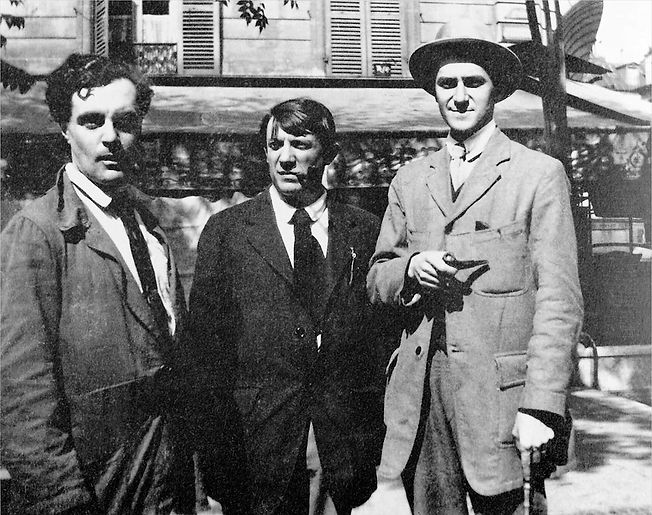
Modigliani, Pablo Picasso and André Salmon, 1916
Sketches of Anna Andreevna Akhmatova by Modigliani made in 1911

Modigliani. Anna Andreevna Akhmatova (1889-1966)
Anna Andreyevna Gorenko (23 June [O.S. 11 June] 1889 – 5 March 1966), better known by the pen name Anna Akhmatova, was one of the most significant Russian poets of 20th century. She was shortlisted for the Nobel Prize in 1965 and received second-most (three) nominations for the award the following year.

Modigliani. Anna Andreevna Akhmatova (1889-1966)
Jeanne Hébuterne: "Devoted companion to the extreme sacrifice."
Jeanne Hébuterne (6 April 1898 – 26 January 1920) was a French painter and art model best known as the frequent subject and common-law wife of the artist Amedeo Modigliani. She took her own life the day after Modigliani died, and is now buried beside him.
A beautiful girl, she was introduced to the artistic community in Montparnasse by her brother André Hébuterne, who wanted to become a painter.
Wanting to pursue a career in the arts, and with a talent for drawing, she chose to study at the Académie Colarossi, where in the spring of 1917 Hébuterne was introduced to Amedeo Modigliani by the sculptress Chana Orloff, who came with many other artists to take advantage of the Academy's live models.
Jeanne began an affair with the charismatic artist, and the two fell deeply in love. She soon moved in with him, despite strong objection from her parents.
Described by the writer Charles-Albert Cingria (1883–1954) as gentle, shy, quiet, and delicate, Jeanne Hébuterne became a principal subject for Modigliani's art.
In the spring of 1918, the couple moved to the warmer climate of Nice on the French Riviera where Modigliani's agent hoped he might raise his profile by selling some of his works to the wealthy art connoisseurs who wintered there. While they were in Nice, their daughter, Jeanne Modigliani (1918–1984), was born on 29 November.
The following spring, they returned to Paris and Jeanne became pregnant again. By this time, Modigliani was suffering from tuberculous meningitis and his health, made worse by complications brought on by substance abuse, was deteriorating badly.
On 24 January 1920 Modigliani died. Hébuterne's family brought her to their home, but she threw herself out of the fifth-floor apartment window the day after Modigliani's death, killing herself and her unborn child.
Her family, who blamed her demise on Modigliani, interred her in the Cimetière de Bagneux. Nearly ten years later, at the request of Modigliani's brother, Emanuele, the Hébuterne family agreed to have her remains transferred to Père Lachaise Cemetery to rest beside Modigliani.
Her epitaph reads: "Devoted companion to the extreme sacrifice."



Photographs of Jeanne Hébuterne
Portraits of Jeanne Hébuterne

* * *


* * *
_by_Amedeo_Modigliani.jpg)
* * *

* * *


* * *

* * *

* * *

* * *
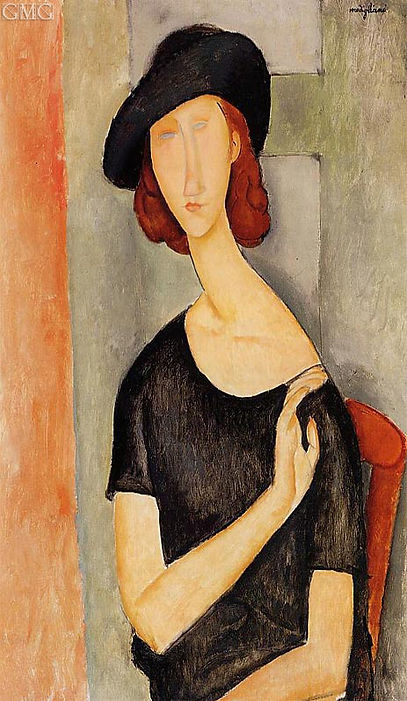

* * *

* * *

* * *
MODIGLIANI: THE SCANDAL OF THE NUDES
The police of the 18th arrondissement were rather free with their hands when they confiscated pictures and drawings by Modigliani after the vernissage on December 3 at the Berthe Weill galleiy at 50 Rue Taitbout. Acting on complaints, they confiscated several nude paintings by the Italian painter “because they were offensive to modesty.” One of them, for which the brief text by the poet Blaise Cendrars in the program praised “the coming and going of passion,” had this derisive slogan: "The matter should be told!" Amedeo Modigliani, who had taken as his motto, “Your actual duty is that of saving your dream,” was nevertheless floating in success. His scandalous nudes were witness to this; he fell very much in love in April with a student from the Colarossi School, Jeanne Hébuterne, with whom he is living on Rue de la Grande-Chaumière.

Nu Couché au coussin Bleu, one of the finest examples of reclining nudes by Modigliani, 1916

Iris Tree, c. 1916, Courtauld Institute of Art

Reclining Nude, 1917
%2C_Koninklijk_4.jpg)
Seated Nude, 1917

Nude, 1917

Nude Sitting on a Divan ("La Belle Romaine"), 1917
.jpg)
Nude on a Blue Cushion, 1917

Nu couché, 1917–18

Nu

Nu

Nu couché, 1917–18

Nu couché, 1917

Nu couché, 1917–18

Nu couché

Nu couché

Nu couché

Nu couché

Nu couché

Nu

Nu couché (sur le côté gauche), 1917